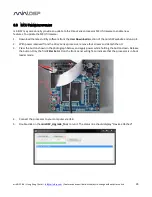
miniDSP Ltd – Hong Kong / Email :
info@minidsp.com
/ Features and specifications subject to change without prior notice
21
Note that it is important that measurements are performed over a sufficiently broad area. If the measurement
area is too small, the result may be over-correction that will sound dry and dull. If using the
Chair
listening area,
spread the microphone positions over a circle with a diameter of at least a meter (three feet). The microphone
should be varied in height from the central position by at least 30 cm (one foot) up and down. If using the Sofa
listening environment, spread the measurement locations over the full listening area and vary the height up and
down by at least 30 cm (one foot).
While the locations indicated are recommended, you can use a different set of locations if necessary. The
important thing is to ensure that the measurement locations are spread over the whole listening area and that
the microphone is moved a sufficient distance vertically as well as horizontally.
In some cases, such as when the listening area is very close to the loudspeakers, the size and in particular the
height of the measurement area can be reduced, to avoid discrepancies caused by varying output response from
the speakers themselves.
3.4.2
Executing measurements
With the microphone in place at the central location and pointed between the two speakers, click on the
Start
button. The
Dirac Series
audio processor will generate a test signal, audible as a frequency sweep through the
left speaker, then the right, and then the left again. While the measurement proceeds, the time-domain graph
of the captured audio signal is displayed at the bottom of the measurement screen. (This graph is related to the
magnitude response but is not the same display. Its purpose is to verify that the recorded signal level is in a
suitable range.)
At the completion of the measurement, the status bar will update with a progress indicator as the program
performs calculations on the measurement. If the measurement was successfully captured, the red arrow
marker will advance to the next location to be measured.
If the program indicates that the measurement was not successful, you will need to take corrective action. The
most common error is related to signal level:
The measurement signal is too low to ensure a clean capture.
The measurement signal is too high and the audio signal has exceeded the maximum level (clipping). This is
shown in red on the signal graph.
In either of the above cases, go back to the
Output & Levels
tab and adjust the output volume or microphone
input gain. Then re-run the measurement. (You do not need to redo the measurements you have already
successfully completed, even if you change volume or gain.)
















































